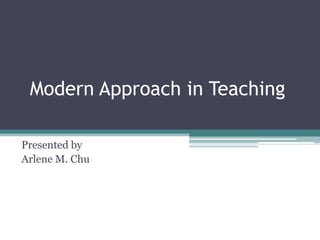
Modern approach in teaching
- 1. Modern Approach in Teaching Presented by Arlene M. Chu
- 2. BackgroundLearning Theory Three Main Categories Behaviorism - focuses only on the objectively observable aspects of learning Cognitivism - cognitive, brain-based learning Constructivism - constructs or builds new ideas or concept
- 3. Learning Theory Behaviorism (Theory developed by B. F. Skinner) Basic Assumption Learning is manifested by a change in behavior The environment shapes behavior The principles of contiguity and reinforcement are central to explaining the learning process 1. contiguity - how close in time two events must be for a bond to be formed 2. reinforcement -any means of increasing the likelihood that an event will be repeated
- 4. Learning Theory Cognitivism (Theory developed by Bode, a gestalt psychologist) Basic Assumption That the memory system is an active organized processor of information That prior knowledge plays an important role in learning 1. contiguity - how close in time two events must be for a bond to be formed 2. reinforcement -any means of increasing the likelihood that an event will be repeated
- 5. Learning Theory Constructivism views learning as a process in which the learner actively constructs or builds new ideas or concepts based upon current and past knowledge or experience. "learning involves constructing one's own knowledge from one's own experiences." Constructivist learning is a very personal endeavor.
- 6. New Modern Approach in Teaching CONNECTIVISM
- 7. Connectivism is a learning theory used in computer science which is based on the premise that knowledge exists in the world rather than simply in the head of an individual.
- 8. Connectivism regard knowledge to exist within systems which are accessed through people participating in activities. It has been dubbed "a learning theory for the digital age", because of how it has been used to explain the effect technology has had on how people live, how they communicate, and how they learn.
- 9. Connectivism One aspect of connectivism is the use of a network with nodes and connections as a central metaphor for learning. a node is anything that can be connected to another node within a network such as an organization: information, data, feelings, images.
- 10. Connectivism Learning is the process of creating connections and developing a network. a process that occurs within nebulous environments of shifting core elements – not entirely under the control of the individual. It can reside outside of ourselves (within an organization or a database).
- 11. Connectivism It is driven by the understanding that decisions are based on rapidly altering foundations. The ability to draw distinctions between important and unimportant information is vital since new information is continually being acquired. The ability to recognize when new information alters the landscape based on decisions made yesterday is also critical.
- 12. New Modern Approach in Teaching PRINCIPLES OF CONNECTIVISM
- 13. Principles (Siemens) Learning and knowledge rests in diversity of opinions. Learning is a process of connecting specialized nodes or information sources. Learning may reside in non-human appliances. Capacity to know more is more critical than what is currently known. Nurturing and maintaining connections is needed to facilitate continual learning.
- 14. Principles Cont. Ability to see connections between fields, ideas, and concepts is a core skill. Currency (accurate, up-to-date knowledge) is the intent of all connectivist learning activities. Decision-making is itself a learning process. Choosing what to learn and the meaning of incoming information is seen through the lens of a shifting reality. While there is a right answer now, it may be wrong tomorrow due to alterations in the information climate affecting the decision
- 16. Social network (facebook, friendster)
- 17. Blogsite
- 18. Discussion board
- 19. Website
- 21. Example - Forum
- 22. Example - Portal
- 23. Thank you!
